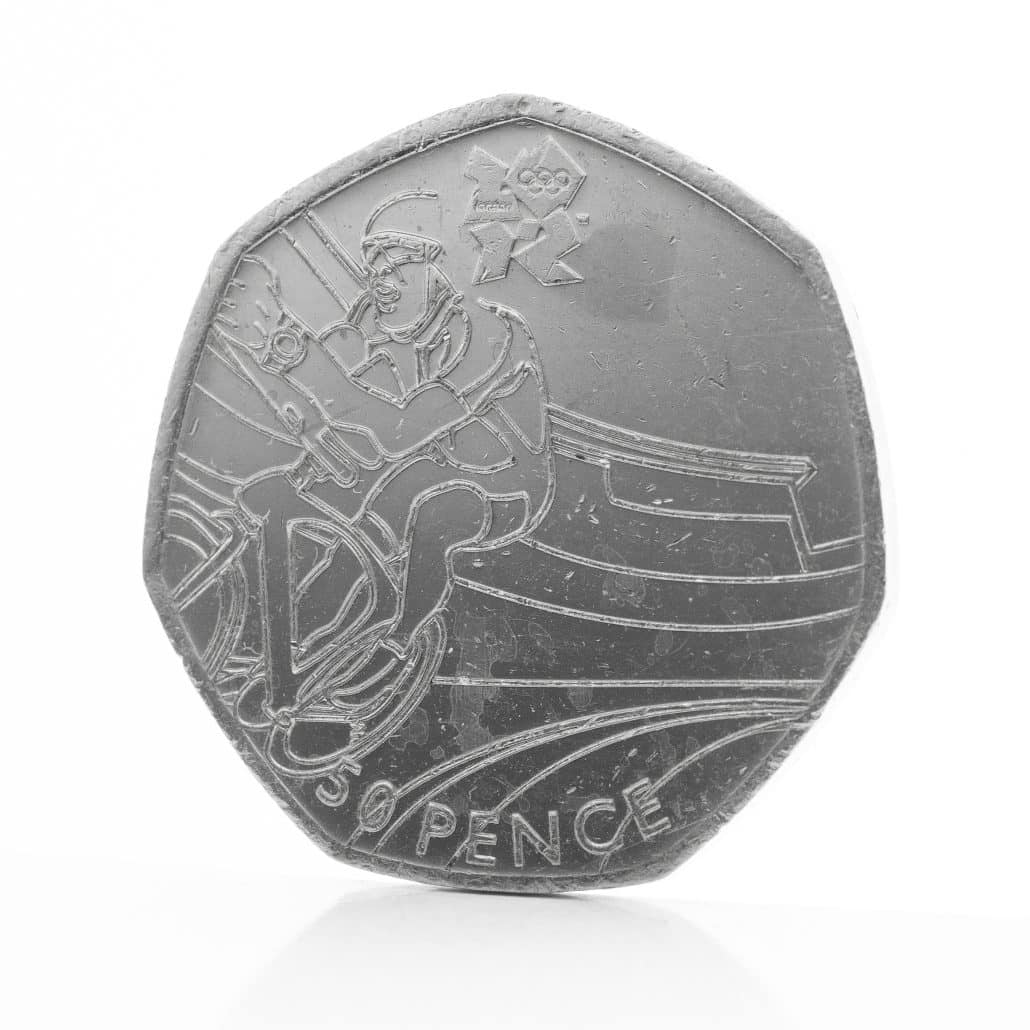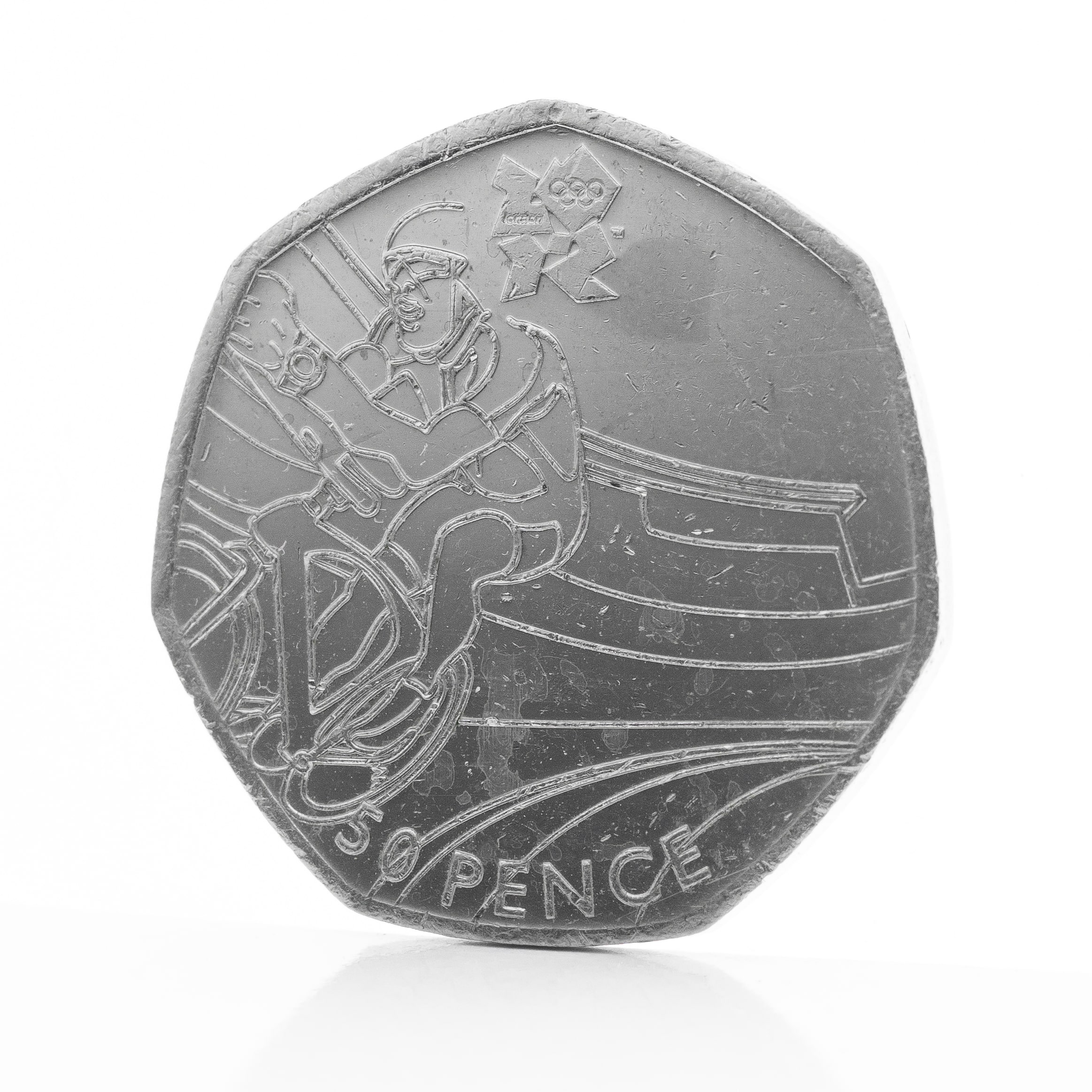The cycling 50p sells for around £1.35 on eBay according to recent sold values in 2022, but how rare even is the coin and is it likely that you would come across one in your change?
Let’s take a look at cycling as a sport during the London Olympics, as well as the mintage and design to see why this coin is sought after.
Cycling at the Olympics
Cycling has been an Olympic sport since the first modern Olympics of 1896 when a road race and five track events took place. It is one of five original sporting events. The others included swimming, fencing, athletics, and artistic gymnastics.
The Summer Olympics in London 2012 was the first to have men and women competing in the same number of events for cycling. Omnium was a new race for both.
Changes were made in the Olympic track cycling, and the men’s and women’s individual pursuit and points race as well as the men’s Madison were removed. Other events were added for the women that included Team sprint, team pursuit and keirin.
The cycling competitions took place at five separate venues that included:
- London Velopark for track cycling and BMX
- Hadleigh Farm in Essex for mountain biking
- The Mall in central London was the starting and ending spot for the road races
- The road races headed out to Surrey to make loops around Box Hill
- Hampton Court Palace in Richmond upon Thames was the spot for time trials
Road racing was included in the 2012 Paralympics as well. The Paralympics events took place at Brands Hatch.
Events consisted of:
- Road cycling – Road race and time trial for men and women
- Track Cycling – Spring, Team sprint, Keirin, Team pursuit, and Omnium for men and women
- Mountain Biking – Cross-country for men and women
- BMX for men and women
A total of 500 athletes competed in a total of 18 events. Despite restrictions put into place intended to prevent the British team from double-medaling, the Great Britain team dominated the leader board. Great Britain won a total of 8 Gold Medals, 2 Silver medals, and 2 Bronze medals.
Germany placed second with one gold, 4 silvers, and 1 bronze for a total of 6 medals. France placed third winning a gold medal and 3 Silvers.
Cycling 50p Mintage
When considering only mintage, the Olympic Cycling 50p is the 19th rarest of the 29 Olympic coins. There were 2,090,500 minted.
This mintage is quite low for a 50p, and is comparable to some of the other Olympic coins such as the weightlifting or hockey coins.
Additionally, the Cycling 50p was minted in a Specimen in card variety with an unknown mintage on a card labelled 9/29.
This coin was also issued in sets that included all 29 Olympic 50p coins as follows:
- London 2012 Sports Collection Collector Album, mintage unknown.
- London 2012 Silver 50p Sports Collection set was issued with 0.925 silver coins with an unknown mintage.
The Cycling Olympic 50 Pence coin was also minted in Silver Brilliant Uncirculated 0.925 Silver limited to a mintage of 30,000
One special 0.917 Gold Proof FDC was presented to the artist, Theo Crutchley-Mack during a special assembly at his school. His school also received a large cash reward.
Design of the Cycling 50p Coin
To represent the 29 sports that were featured on the 2012 London Olympics coins, the Royal Mint launched a competition to find designers to best represent the commemorative coin series. To enter, contestants had to be at least 13 years old. However, there were two special competitions specifically designed for younger entrants.
One of the design competitions was for children between the ages of 6 and 12 that was held by the children’s television show Blue Peter. There was another that was solely for secondary school and college students. The Cycling 50 pence coin design was selected from the secondary school and college student competition. Theo Crutchley-Mack, just 16 years old, was the one chosen.

The coin’s reverse design features a cyclist inside a velodrome. The cyclist is on the left side of the coin with arms resting on the handlebars of the bike. The cyclist’s legs are in full pedalling motion, and there is a look of determination on the athlete’s face. The straight and curved lines behind him represent the velodrome and help to imply fast motion.
All 29 Olympic 50p special commemorative coins show the 2012 Olympic or Paralympic logo at the centre top of the reverse side. The logo was designed by the consultancy firm of Wolff Olins.
The words 50 PENCE are centred and slightly curved upward at the bottom underneath the image on each of the 29 coins. On the Cycling coin, the curved lines in the background intersect the words.
All 29 of the special commemorative Olympic coins were issued to celebrate the 2012 London Olympics. Like other 50 pence coins, the special commemorative coins have the same heptagon shape.
The 50p coins also consist of Cupro-nickel alloy, with a weight of 8.00 g, a 27.3 mm diameter, and a thickness of 1.78 mm.
The Obverse design is an image of Queen Elizabeth II as designed by Ian Rank-Broadley. The words ELIZABETH II * D * G * REG * F * D * 2011 surround her image along the outer rim.
The edge of the coin is plain with no inscription.
About the Designer
A few years before the special commemorative Olympic coins were issued, the Royal Mint held a competition to select 29 individual designers. The winners each represented one sport that they would design on their own individual coin. The designer chosen for the Cycling Olympic 50p coin was Theo Crutchley-Mack.
He was just a young teenage schoolboy from Rishworth School in Halifax, but he became well-known quite fast. Theo Crutchley-Mack was just 16 years old when he entered the coin design competition. He was a student who had taken an art class and an avid cyclist.
The rules of the competition stated that you had to be at least 13 years of age to enter. Although he was within the age range to enter the Royal Mint contest, Theo entered through the nationwide secondary school competition. More than 3,000 other students entered as well.
When he learned he had won and was presented with a gold version of his coin at school, he was shocked. He said that he needed a bit more time for it to sink in. At the time his design was selected, he had just finished his GCSE mock exams.
The judges chose his design because they could see the speed, drama, and excitement involved in the sport of cycling that Theo managed to capture in the design.
